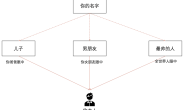前两篇文章是关于在关节空间中进行机械臂的运动控制: MoveIt简单编程实现关节空间机械臂运动(逆运动学) MoveIt简单编程实现关节空间机械臂运动(正运动学) 通过对关节空间下的机器人6个轴进行控制,每个轴的变化都是通过插补进行完成运动,六个轴互相不会关心其他轴是如何运动的,机器人轴端在两个点之间走出的轨迹是任意的曲线。 但是对于一些任务重,要求机械臂终端轨迹的形状是直线或者圆弧等,即对轨迹的形状是有要求的,这个时候就要使用笛卡尔孔家,增加笛卡尔路径约束。 首先使用以下命令,看一下执行的效果:
roslaunch probot_anno_moveit_config demo.launch
走直线:
rosrun probot_demo moveit_cartesian_demo.py _cartesian:=True
自由曲线:
rosrun probot_demo moveit_cartesian_demo.py _cartesian:=False
import rospy, sys
import moveit_commander
from moveit_commander import MoveGroupCommander
from geometry_msgs.msg import Pose
from copy import deepcopy
class MoveItCartesianDemo:
def __init__(self):
# 初始化move_group的API
moveit_commander.roscpp_initialize(sys.argv)
# 初始化ROS节点
rospy.init_node('moveit_cartesian_demo', anonymous=True)
# 是否需要使用笛卡尔空间的运动规划,获取参数,如果没有设置,则默认为True,即走直线
cartesian = rospy.get_param('~cartesian', True)
# 初始化需要使用move group控制的机械臂中的arm group
arm = MoveGroupCommander('manipulator')
# 当运动规划失败后,允许重新规划
arm.allow_replanning(True)
# 设置目标位置所使用的参考坐标系
arm.set_pose_reference_frame('base_link')
# 设置位置(单位:米)和姿态(单位:弧度)的允许误差
arm.set_goal_position_tolerance(0.001)
arm.set_goal_orientation_tolerance(0.001)
# 设置允许的最大速度和加速度
arm.set_max_acceleration_scaling_factor(0.5)
arm.set_max_velocity_scaling_factor(0.5)
# 获取终端link的名称
end_effector_link = arm.get_end_effector_link()
# 控制机械臂先回到初始化位置
arm.set_named_target('home')
arm.go()
rospy.sleep(1)
# 获取当前位姿数据最为机械臂运动的起始位姿
start_pose = arm.get_current_pose(end_effector_link).pose
# 初始化路点列表
waypoints = []
# 如果为True,将初始位姿加入路点列表
if cartesian:
waypoints.append(start_pose)
# 设置路点数据,并加入路点列表,所有的点都加入
wpose = deepcopy(start_pose)#拷贝对象
wpose.position.z -= 0.2
if cartesian: #如果设置为True,那么走直线
waypoints.append(deepcopy(wpose))
else: #否则就走曲线
arm.set_pose_target(wpose) #自由曲线
arm.go()
rospy.sleep(1)
wpose.position.x += 0.15
if cartesian:
waypoints.append(deepcopy(wpose))
else:
arm.set_pose_target(wpose)
arm.go()
rospy.sleep(1)
wpose.position.y += 0.1
if cartesian:
waypoints.append(deepcopy(wpose))
else:
arm.set_pose_target(wpose)
arm.go()
rospy.sleep(1)
wpose.position.x -= 0.15
wpose.position.y -= 0.1
if cartesian:
waypoints.append(deepcopy(wpose))
else:
arm.set_pose_target(wpose)
arm.go()
rospy.sleep(1)
#规划过程
if cartesian:
fraction = 0.0 #路径规划覆盖率
maxtries = 100 #最大尝试规划次数
attempts = 0 #已经尝试规划次数
# 设置机器臂当前的状态作为运动初始状态
arm.set_start_state_to_current_state()
# 尝试规划一条笛卡尔空间下的路径,依次通过所有路点
while fraction < 1.0 and attempts < maxtries:
#规划路径 ,fraction返回1代表规划成功
(plan, fraction) = arm.compute_cartesian_path (
waypoints, # waypoint poses,路点列表,这里是5个点
0.01, # eef_step,终端步进值,每隔0.01m计算一次逆解判断能否可达
0.0, # jump_threshold,跳跃阈值,设置为0代表不允许跳跃
True) # avoid_collisions,避障规划
# 尝试次数累加
attempts += 1
# 打印运动规划进程
if attempts % 10 == 0:
rospy.loginfo("Still trying after " + str(attempts) + " attempts...")
# 如果路径规划成功(覆盖率100%),则开始控制机械臂运动
if fraction == 1.0:
rospy.loginfo("Path computed successfully. Moving the arm.")
arm.execute(plan)
rospy.loginfo("Path execution complete.")
# 如果路径规划失败,则打印失败信息
else:
rospy.loginfo("Path planning failed with only " + str(fraction) + " success after " + str(maxtries) + " attempts.")
rospy.sleep(1)
# 控制机械臂先回到初始化位置
arm.set_named_target('home')
arm.go()
rospy.sleep(1)
# 关闭并退出moveit
moveit_commander.roscpp_shutdown()
moveit_commander.os._exit(0)
if __name__ == "__main__":
try:
MoveItCartesianDemo()
except rospy.ROSInterruptException:
pass
- 获取参数,使用
rospy.get_param(param_name):
# 获取全局参数
rospy.get_param('/global_param_name')
# 获取目前命名空间的参数
rospy.get_param('param_name')
# 获取私有命名空间参数
rospy.get_param('~private_param_name')
# 获取参数,如果没,使用默认值
rospy.get_param('foo', 'default_value')
2.路径规划API,(plan, fraction) = arm.compute_cartesian_path 返回值:
- plan:规划出来的运动轨迹
- fraction:描述规划成功的轨迹在给定路径点列表的覆盖率【0~1】。如果fraction小于1,说明给定的路径点列表没有办法完整规划
C++代码解析:
#include <ros/ros.h>
#include <moveit/move_group_interface/move_group_interface.h>
#include <moveit/robot_trajectory/robot_trajectory.h>
int main(int argc, char **argv)
{
//初始化节点
ros::init(argc, argv, "moveit_cartesian_demo");
//引入多线程
ros::AsyncSpinner spinner(1);
//开启多线程
spinner.start();
//初始化需要使用move group控制的机械臂中的arm group
moveit::planning_interface::MoveGroupInterface arm("manipulator");
//获取终端link的名称
std::string end_effector_link = arm.getEndEffectorLink();
//设置目标位置所使用的参考坐标系
std::string reference_frame = "base_link";
arm.setPoseReferenceFrame(reference_frame);
//当运动规划失败后,允许重新规划
arm.allowReplanning(true);
//设置位置(单位:米)和姿态(单位:弧度)的允许误差
arm.setGoalPositionTolerance(0.001);
arm.setGoalOrientationTolerance(0.01);
//设置允许的最大速度和加速度
arm.setMaxAccelerationScalingFactor(0.5);
arm.setMaxVelocityScalingFactor(0.5);
// 控制机械臂先回到初始化位置
arm.setNamedTarget("home");
arm.move(); //规划+移动
sleep(1); //停1s
// 获取当前位姿数据最为机械臂运动的起始位姿
geometry_msgs::Pose start_pose = arm.getCurrentPose(end_effector_link).pose;
//初始化路径点向量
std::vector<geometry_msgs::Pose> waypoints;
//将初始位姿加入路点列表
waypoints.push_back(start_pose);
start_pose.position.z -= 0.2;
waypoints.push_back(start_pose);
start_pose.position.x += 0.1;
waypoints.push_back(start_pose);
start_pose.position.y += 0.1;
waypoints.push_back(start_pose);
// 笛卡尔空间下的路径规划
moveit_msgs::RobotTrajectory trajectory;
const double jump_threshold = 0.0;
const double eef_step = 0.01;
double fraction = 0.0;
int maxtries = 100; //最大尝试规划次数
int attempts = 0; //已经尝试规划次数
while(fraction < 1.0 && attempts < maxtries)
{
fraction = arm.computeCartesianPath(waypoints, eef_step, jump_threshold, trajectory);
attempts++;
if(attempts % 10 == 0)
ROS_INFO("Still trying after %d attempts...", attempts);
}
if(fraction == 1)
{
ROS_INFO("Path computed successfully. Moving the arm.");
// 生成机械臂的运动规划数据
moveit::planning_interface::MoveGroupInterface::Plan plan;
plan.trajectory_ = trajectory;
// 执行运动
arm.execute(plan);
sleep(1);
}
else
{
ROS_INFO("Path planning failed with only %0.6f success after %d attempts.", fraction, maxtries);
}
// 控制机械臂先回到初始化位置
arm.setNamedTarget("home");
arm.move();
sleep(1);
ros::shutdown();
return 0;
}



 任意曲线 Python代码以及解析:
任意曲线 Python代码以及解析: 


